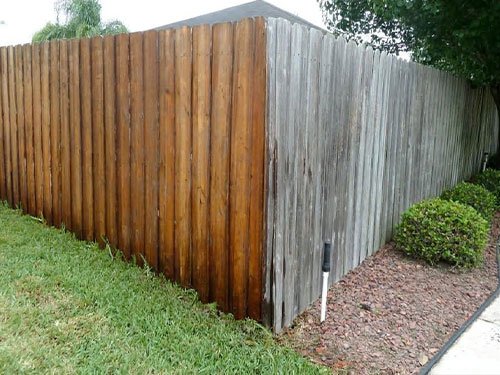How to Choose the Right Fencing Stain for Your Residential Or Commercial Property
When it comes to boosting the look and longevity of your home's fence, picking the best discolor is a critical choice that requires careful factor to consider. Exactly how can you guarantee that you pick the perfect fencing tarnish that aligns with your building's design and upkeep needs?
Understanding Wood Types
To select the proper fencing stain, it is vital to have a comprehensive understanding of the numerous kinds of wood commonly used for fence. When choosing a fence tarnish, it is vital to consider the kind of wood being used to guarantee compatibility and optimum security. Understanding the features of different timber types will assist you make a notified decision when it comes to choosing the appropriate fence stain for your home.
Selecting the Right Color
Choosing a proper tone for your fence tarnish is a crucial choice that substantially influences the total aesthetic allure of your property. The color you pick need to enhance the design of your home, mix harmoniously with the surroundings, and reflect your individual preference. When picking a shade, think about the existing color combination of your building. For an all-natural appearance, natural tones like browns, greens, or grays function well. These colors can help the fence mix right into the landscape and produce a natural look. If you like a more modern-day or strong appearance, take into consideration selecting darker shades like black or deep charcoal for a striking comparison. Lighter shades such as whites or light grays can make a fencing show up bigger and include a touch of beauty to your residential property. Ultimately, the right color option will certainly improve the charm of your fencing and raise the general curb charm of your home.

Thinking About Openness Levels
When picking the right color for your fencing tarnish, one more important aspect to take into consideration is the level of openness that will certainly best fit your home's aesthetic and maintenance needs. Openness levels in fencing spots typically fall under 3 classifications: transparent, semi-transparent, and strong. Transparent spots enable the all-natural charm of the timber to show through while offering minimal protection against the components. They are excellent for brand-new or properly maintained fencings where showcasing the wood grain is a priority. Semi-transparent spots supply an equilibrium in between shade enhancement and defense, allowing some timber grain to be visible while supplying moderate shielding from UV rays and moisture. Strong discolorations, on the other hand, provide one of the most defense as they entirely cover the wood with an opaque surface. These appropriate for older fences or those looking for significant defense or shade adjustment. Take into consideration the level of exposure your fencing encounters, the wanted upkeep regularity, and the aesthetic you want to accomplish when choosing the ideal transparency level for your fencing discolor.
Evaluating Maintenance Needs
Taking into consideration the durability and upkeep of your fence, evaluating the maintenance requirements is essential in figuring out one of the most suitable fence tarnish for your residential or commercial property. The degree of maintenance needed for your fencing can vary depending on variables such as the sort of wood, weather conditions in your location, and helpful site your personal preferences.
When examining upkeep needs, it is necessary to think about the durability of the fence tarnish. Some spots require even more regular reapplication than others, so selecting a stain with a much longer life-span can help in reducing the general maintenance demands of your fencing (Fence Staining Service). In addition, aspects such as resistance to UV rays, water, and mildew can influence how typically you need to re-stain your fencing

Examining Samples Before Application
Prior to applying any type of fencing tarnish, it is advisable to perform example examinations to make sure compatibility with the timber and preferred visual result. Examining samples permits you to analyze how the discolor will connect with the specific type of timber used in your fencing, as different timbers can soak up stains in different ways. To start, choose a small unnoticeable location of the fence to use the stain examples.
Final Thought
To conclude, picking the proper fencing tarnish for your building involves recognizing the wood kind, selecting the appropriate shade, considering transparency levels, evaluating upkeep demands, and testing examples before application (Fence Staining Service). By taking these elements into factor to consider, you can guarantee that your fence discolor enhances your building while supplying the essential protection and sturdiness. Make an educated choice to boost the appearance and durability of your fence